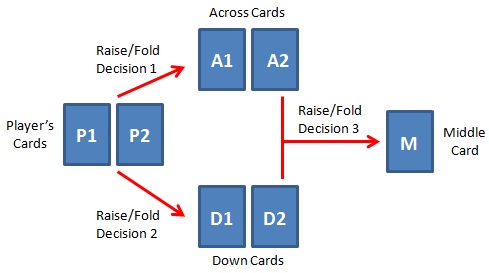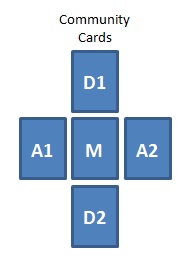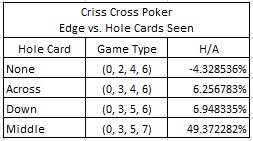Criss Cross Poker Hole-Card Play

Criss Cross Poker (CCP) is yet another stud poker clone. Like all poker clones, CCP faces a very tough road towards success. In recent months I’ve been contacted by a few people who have asked me to take a look at hole-carding CCP. Now that CCP is getting a few placements, I decided to do the analysis. Because CCP plays a lot like Mississippi Stud (MS), I thought that CCP might have very significant hole-card issues. As I will show, the player can get up to a 49.37% edge over the house seeing just one hole-card. I think that qualifies as significant.
RULES FOR CCP
CCP has three similarities with MS:
-
The player competes against a pay table, not against the dealer.
-
There are three rounds of betting. Each round, the player must either fold, raise 1 or raise 3.
-
The hand pushes with a pair of 6’s through T’s and pays for a pair of J’s or better. All other hands lose.
Of course, CCP is not MS, so there must also be some differences. To understand how CCP plays, consider the following picture.

The player is simultaneously playing two five-card stud hands:
-
The "Across" hand is the five-card poker hand consisting of the cards {P1, P2, A1, A2, M}.
-
The "Down" hand is the five-card poker hand consisting of the cards {P1, P2, D1, D2, M}.
Here are the rules:
-
The player places two equal “Ante” wagers, the “Across Ante” and the “Down Ante.”
-
The player is dealt two cards {P1, P2}.
-
Raise/Fold Decision 1 (Across Raise): After inspecting his cards, the player can either fold, in which case he forfeits his Ante wagers, or he can raise 1 or raise 3.
-
The two Across cards {A1, A2} are dealt face up.
-
Raise/Fold Decision 2 (Down Raise): After the Across cards have been dealt, the player can either fold, in which case he loses all wagers, or he can raise 1 or raise 3.
-
The two Down cards {D1, D2} are dealt face up.
-
Raise/Fold Decision 3 (Middle Raise): After the Across cards and Down cards have been dealt, the player can either fold, in which case he loses all wagers, or he can raise 1 or raise 3.
-
The Middle card {M} is dealt face up and all wagers are resolved.
Note that the Across cards, Down cards and Middle card are community cards that are shared by all players at the table.
The rules for the game are fairly easy. It’s just two-way Mississippi Stud. With this in mind, the way that wagers are resolved becomes intuitive:
Across Ante/Raise
-
If the Across hand is a pair of Jacks or Better, then the Across Ante is paid even money and the Across Raise is paid according to the bonus pay table below.
-
If the Across hand is a pair of 6’s to T’s, then the Across Ante and Across Raise both push.
-
Otherwise, the Across Ante and Across Raise are lost.
Down Ante/Raise
-
If the Down hand is a pair of Jacks or Better, then the Down Ante is paid even money and the Down Raise is paid according to the bonus pay table below.
-
If the Down hand is a pair of 6’s to T’s, then the Down Ante and Down Raise both push.
-
Otherwise, the Down Ante and Down Raise are lost.
Middle Raise
-
The payout for the Middle Raise is based on the higher ranking five-card stud hand between the Across hand and the Down hand.
-
If the Across hand is higher ranking five-card stud hand, then the Middle Raise pays the same odds as the Across Raise.
-
If the Down hand is the higher ranking five-card stud hand, then the Middle Raise pays the same odds as the Down Raise.
Here is the bonus pay table for paying the Across Raise, Down Raise and Middle Raise:
-
Royal Flush pays 500-to-1
-
Straight Flush pays 100-to-1
-
Four of a Kind pays 40-to-1
-
Full House pays 12-to-1
-
Flush pays 8-to-1
-
Straight pays 5-to-1
-
Three of a Kind pays 3-to-1
-
Two Pair pays 2-to-1
-
High Pair (J, Q, K, A) pays 1-to-1
-
Middle Pair (6, 7, 8, 9, T) is a push
-
All others lose
I apologize for being so long-winded about this game. When I was working on the math, I decided that the actual layout of the game made it difficult to understand the rules and strategies. Here is the actual layout for the community cards, hence "Criss Cross":

BASIC STRATEGY
One way to view the basic game (no exposed hole-cards) is that the player makes his first wager without seeing any cards, his second wager after seeing two cards, his third wager after seeing four cards and his last wager after seeing six cards. Thus, the basic game is (0, 2, 4, 6).
The house edge for CCP is 4.328536%. This house edge is the percentage of the total initial money wagered, remembering that there are two initial Ante wagers. Thus if a player places two $5 Ante wagers, then his expected loss is approximately 43.3 cents.
Basic strategy for the player’s first raise (the Across Raise) is easy to describe:
-
If the player holds any pair, or QJ suited, then the player should raise 3.
-
If the player holds 23, 24, 25, 34, 35, 45 (offsuit), then the player should fold.
-
Otherwise the player should raise 1.
The following Excel file gives the EV’s for Across Raise decision:
The next strategic decision for the player is the Down Raise. The player knows four cards {P1, P2, A1, A2} when making this wagering decision. Intuitively, the strategy should be about the same as the Across Raise, as the Across hand and Down hand pay independently. With a few exceptions, playing "Basic strategy" for the Down Raise is correct, and for those cases when the strategy does change, the difference in edge between the two is slight.
The reason for these slight changes in strategy is that if the player makes a good hand with the Across Raise, then he is less likely to make a good hand after his Down Raise. That is, the outs used by hitting good cards on the Across Raise removes those outs for the Down Raise. Conversely, if the player’s Across cards are a bust, then he is more likely to hit good Down cards, improving the odds for his Down Raise.
Here are some typical exceptions:
-
Suppose the player holds the cards 2c, 3c. On the Across bet, basic strategy is to raise 1. But if the Across cards are 4c, 7d, then the player should fold the Down bet. The 4c is a straight and flush out that is not available to the Down hand. Raise 1 has EV = - 3.129, whereas folding has EV = -3.
-
Suppose the player holds Jc, Kc. On the Across bet, basic strategy is to raise 1. But if the Across cards are 2c, 3c, then there is a better chance the player will make a pair of Jacks or Kings, or complete the straight. It is now correct for the player to raise 3 on the Down bet. Raise 1 has EV = 4.9356, whereas raise 3 has EV = 4.9535.
-
Next, suppose the player is holding the small pair 2c,2d. On the Across bet, basic strategy is to raise 3. If the Across cards are 2h, 3c, then the player made Trips on his Across bet. However, there is one less "2" available for the Down bet, so now the correct Down play is raise 1. Raise 1 has EV = 26.4459 and raise 3 has EV = 26.1156.
-
As you might imagine, there are no situations where you raise 3 on the Across bet and subsequently fold on the Down bet.
The following Excel files give an exhaustive listing of the EV’s and basic strategy for every four card combination that can occur after the player’s two initial cards and the two Across cards.
The following files cover the case where the player’s Across Raise was 1 unit. Caution, these files are each about 12MB:
The following file covers the case where the player’s Across Raise was 3 units. It is about 3MB:
I am not going to take the time to quantify these files into a fixed set of rules for basic strategy for the Down Raise.
HOLE CARDING CRISS CROSS POKER
I will consider three hole-card scenarios.
In the first, the AP sees one of the Across cards. This information can be used for his Across Raise, but after that, the usefulness of the information has expired. The game is therefore (0, 3, 4, 6).
In the second case, the AP sees one of the Down cards. This information can be used for both the Across Raise and the Down Raise, but is not useful for the final Middle Raise. The game is therefore (0, 3, 5, 6).
The final situation is when the AP sees the Middle card. This card can be used for all three raises. In particular, the AP’s final raise, the Middle Raise, will be made with 100% knowledge about the final poker rank for both the Across Hand and the Down Hand. In the case of seeing the Middle card, the game is (0, 3, 5, 7).
The following table summarizes the edge for each of these hole-card scenarios:

There are combin(52,2)*50 = 66300 possible ways the player can be dealt two initial cards and see one hole-card. The following Excel file gives the Fold/Raise EVs and correct hole-card strategy decision for each of these 66300 starting situations. Different tabs in this Excel file cover the different hole-card situations (0, 3, 4, 6), (0, 3, 5, 6) and (0, 3, 5, 7). Note that this file covers only the Across Raise. I have not created any data files for the Down Raise or Middle Raise. This file is about 5MB.
In looking through this Excel file, hole-card strategy for the Across Raise would be straightforward to write out. Maybe I am just feeling lazy, but I’m not going to do that work for this game (at least, not yet). However, I am certain that if a high-level AP spotted a middle card, he would be all over this game like a duck to a June bug. An edge of 49% is just too good to pass up. Likewise, if a sloppy dealer is exposing more than one hole card, the APs will be there.
I will offer one possible game protection solution. I suggest dealing the game by hand, as follows:
-
Players make their Ante bets.
-
Remove the cards from the automatic shuffler.
-
Burn the top card and deal two cards to each player.
-
Players make their Across bet.
-
Burn the top card and deal the two Across cards face up.
-
Players make their Down bet.
-
Burn the top card and deal the two Down cards face up.
-
Players make their Middle bet.
-
Burn the top card and deal the Middle card face up.
-
Reconcile all remaining wagers.
Of course, if you have either a "sharp" dealer or an incompetent dealer, this could backfire.


